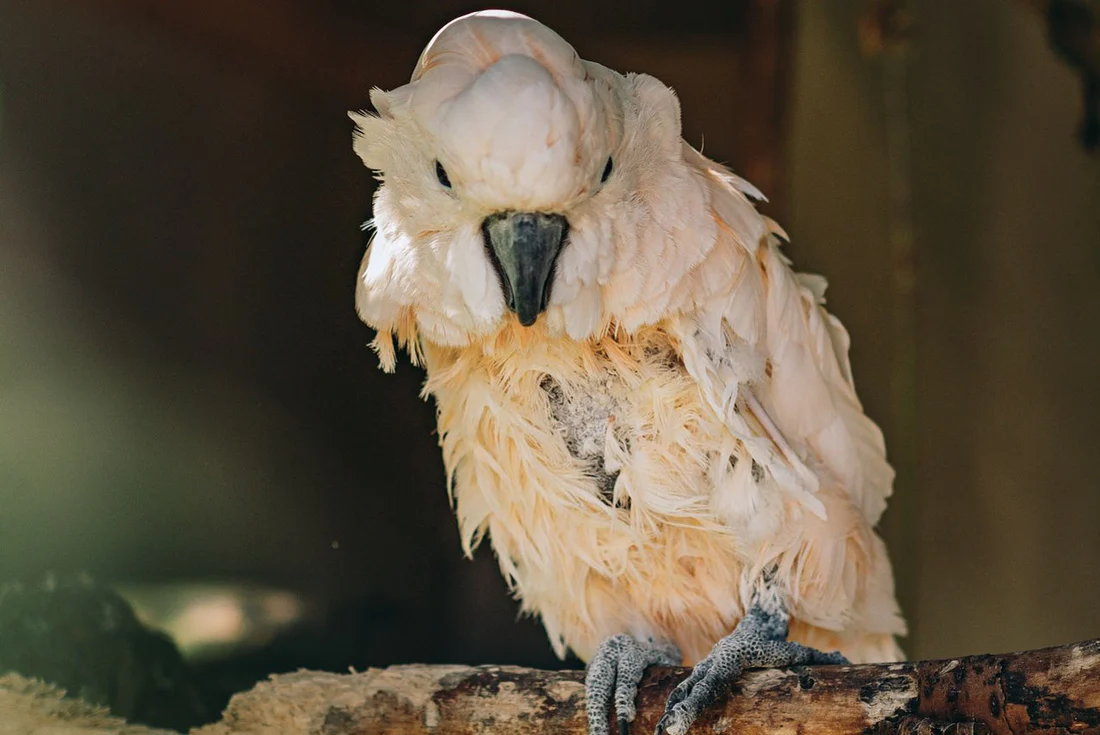
Parrot Molting Symptoms And How Best To Deal With It
One of the things a new parrot owner might feel anxious about is when they suddenly spot a lot of dropped feathers around their bird’s living quarters. Very often, this is the result of molting. Molting is a completely natural and harmless process. During this process, you can try to support your bird as they may often feel itchy, and may need you to help them feel comfortable. On the other hand, fallen feathers could also be the result of destructive behavior by the parrot.
This article will give you some insights about your parrot molting, its symptoms, as well as its significance to the bird. This will help you differentiate between a normal molting process from a destructive behavior.
Jump To Section
What is Molting?
Molting is when a bird sheds old feathers to make way for new ones to facilitate efficient flight and courtship. It happens to parrots once or twice a year. Parrot needs to molt to make way for new plumage. They do it gradually from wings, body, and finally the tail feathers, but not all at once. This allows them to still be able fly even when they are molting. Molting can also occur only to certain feathers of the body, also known as partial molting. A molting season does not necessarily mean that the parrot will renew every single feather of its body.
Molting is triggered by sunlight or similar forms of artificial light. Parrots that only see light from modern windows are likely to experience unusual molting. Majority of the modern windows cannot replicate natural sunlight that is needed by the parrots. Which is why you’ll find pet parrots molting during weird times of the year.
What Causes Parrot Molting?
Molting results from a natural rhythm. It happens naturally during the year just like breeding and migratory habits. In the wild, birds do not usually molt during breeding and migratory seasons as these activities, in addition to molting, are energy-intensive processes. For captive parrots that might have had their natural rhythms disrupted by indoor living, they might molt at unusual times of the year.
How Do Parrots Molt?
Nature is amazing, and in the case of parrots, they molt in fascinating ways.
Birds usually do a symmetrical molt. That means, when one feather on the left side of the body falls out, the same feather on the other side of the body will fall out very soon after. This enables the bird to maintain balance in flight. Every feather on a bird is crucial to flight dynamics. If too many feathers on one side of the body fall out at once, the bird might not be able to fly efficiently.
Birds generally have a sequence of molting. This means that certain feathers would tend to fall off first, and others later. As molting of flight (wing) feathers and tail feathers are more easily observable, they have been better documented.
Contour (body) feathers are harder to track, so we are not completely sure if there is a specific sequence to the molting. However, it is known that ornate feathers (those used for courtship) generally molt last, in order to preserve them for as long as possible.
Why Do Parrots Need To Molt?
Parrots need to undergo the molting process because their feathers wear out. Just like other birds, parrots need pristine feathers to be able to fly around efficiently. During a parrot’s daily activities, they might brush against surfaces, engage in fights with other creatures, or preen their own feathers. With time, the feathers get broken or tattered and it becomes less ideal for the parrot to fly around. That’s when the parrot will need to molt to replace the damaged feathers with new ones. It’s essential for your parrot to keep every feather healthy to fly properly as well as keep them warm.
Feathers do not regenerate and grow continuously like a human’s hair or fingernails. If they did so, they wouldn’t be appropriate for flight; therefore, they grow up to a certain length and stops. This means that they feathers require consistent molting for replacement and renewal.
Generally, birds also molt not only for better flight dynamics, but also for courtship. In some species of birds, they grow different colored plumage during the breeding season to attract potential mates, and then revert to their original colors after the breeding season. Some birds also molt for self-protection – to camouflage among changing landscapes and seasons (dry, rocky habitats during summer versus white snow during winter).
It is not known if parrots molt for reasons other than feather renewal for flight.
How Do I Know If My Parrot Is Molting?
You can easily become aware of parrots molting as the first thing you will notice is plenty of feathers lying around around your bird’s cage or perch. Parrots may shed one or two feathers occasionally, but when you notice more feathers on the ground than usual, it is likely that your parrot is undergoing a molt.
Here are some other symptoms of molting that will enable you to understand what your parrot is going through. This will allow you to help them ease the discomfort the parrot feels that you could have otherwise mistaken for some sickness.
Irritability
You may see your bird scrubbing itself against surfaces and objects because the process is often itchy and uncomfortable to your parrot.
Defensive behavior or “moodiness”
This is due to the irritation they are experiencing. You may notice your parrot biting objects more, or even lunge at you or bite you.
Slight lethargy
As molting and regrowing new feathers is an energy-intensive process, your parrot might be less active than usual, wanting to interact less with you, or more sleepy than usual. If this is the case, letting your bird have a bit more alone time can be good. On the other hand, some owners have reported that their parrots become more “cuddly” during such moments as they seek comfort and neck scratches from their owners to soothe their itch!
Bald patches
Sometimes, birds go through a particularly heavy molt, where they shed more feathers than usual. This may result in bald patches or areas where feathers are sparse (see picture below, around the neck area of the bird). This is normal and nothing to be worried about, as long as the feathers in the sparse areas eventually grow back.
Appearance of “pins” or white, prickly-looking growths
These are pin feathers (again, see picture below, around the head area of the bird) and is a sign that new feathers are growing out as a result of previously molted feathers.
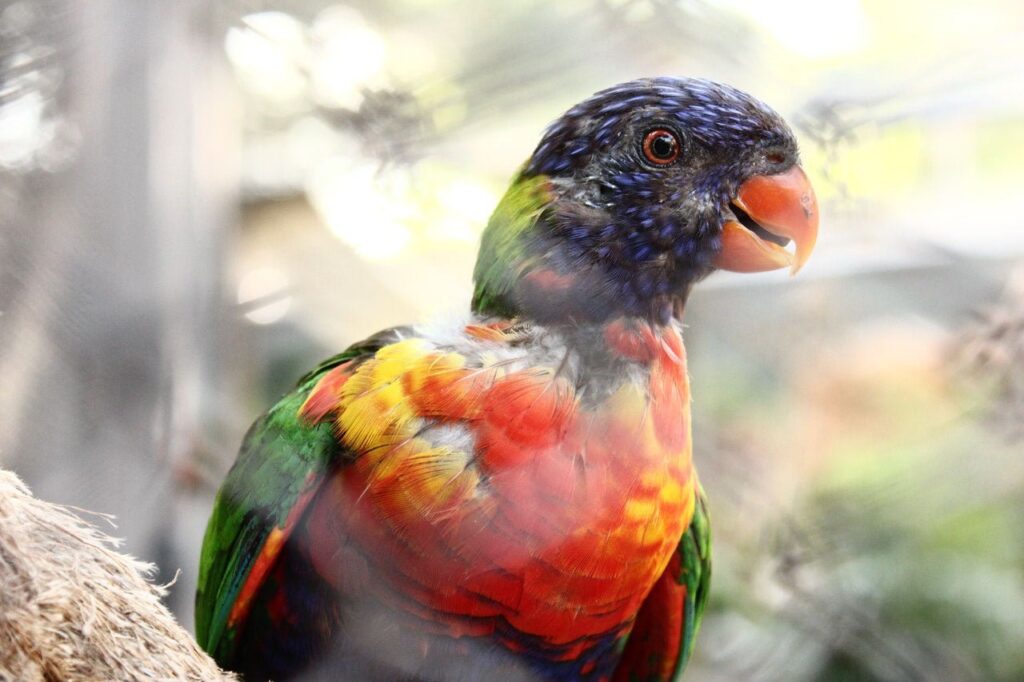
Is My Parrot Molting Or Plucking?
The good thing is that you can differentiate feathers from real molting and those caused by other vices. The feathers from molting contain the entire shaft; that is, you can actually see both the tip and shaft. Splintered, bent, or chewed feather tips and shafts is a clear indication that your parrot is engaging in a feather-picking or “barbering” behavior. You will need to find the cause to stop such destructive behavior.
Plucking happens when a parrot forcefully removes its feathers. Some common causes include:
- Emotional stress (such as from living in an undesirable condition)
- Diseases, allergies, or infection (irritation in a certain part of the body resulting in the bird fussing over it, and hence plucking)
- Boredom (lack of suitable toys and mental stimulation)
- Poor nutrition (resulting in poorly-grown feathers)
- Unclean, unhygienic vicinity around the bird (including living with smokers who smoke near the bird)
- Breeding season (some hens pluck their own feathers to line their nests as bedding for their chicks – this is actually common and normal, and should not pose an issue as long as the feathers grow back)
As opposed to molting, plucking can result in:
- Bare skin patches all over your parrot unlike in molting where shedding of skin is systematic from the head to the rear end.
- Chewed-up and broken feathers. In molting, you will notice mostly intact feathers with little damage. Plucked or barbered feathers look to be in poor condition.
- Inflamed, bleeding, or flaky skin, where the plucking or barbering behavior goes too far and the parrot starts to mutilate its own skin.
You will need to identify the reason for plucking and try to guide your parrot out of the destructive behavior if you have ascertained that your bird is indeed plucking its feathers. It would be best to consult a vet for a diagnosis and to get ideas on how to prevent your parrot from plucking.
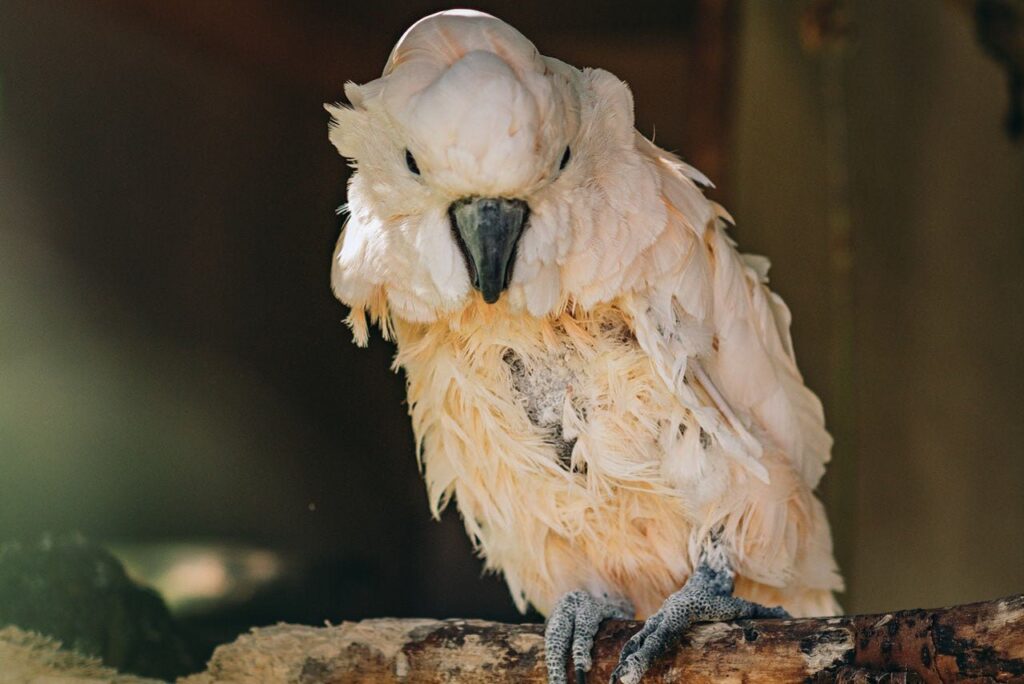
This cockatoo has a bald patch on its chest, although we can’t be sure whether it is due to plucking or a particularly heavy molt.
What Time Of The Year Do Parrots Molt?
A parrot molts once or twice a year, usually in fall and spring. The time of the year varies across species. Some species molt earlier in the year while others molt later. Large species of parrots may molt once in 2 years since their molting process takes about six months to complete, and it begins in fall.
Smaller species of parrots like cockatiels may molt up to 3 times in a year because their molting process takes a shorter time. Their molting time is only influenced by nutritional needs, temperature, migration, parrot’s overall health, and its reproductive state.
The time of molting is also related to change in seasons in accordance to where you live. Change in day length stimulates molting as well as other parrot’s activities like breeding. Your parrot is likely to molt in September, October, and November if you live in the US.
As opposed to wild parrots, pet parrots are likely to molt at odd times since most of them are not exposed to natural sunlight. Their molting time may be affected by temperatures and is not consistent throughout the years.
How Long Does A Parrot Molt Last?
The time it takes for a parrot to molt varies across species. While larger parrots molt only once in two years, smaller parrots molt as much as three times in a year. It takes around one to two months for smaller parrots to lose their old plumage and get a new one.
Technically, larger parrots will take longer to molt. They will take about six months to shed their old feathers. That’s why large parrots often molt once in two years since their feathers are way bigger.
As parrot owners, the long durations of feather molting can mean messier cages and living spaces! It would be best to clean the area more often to remove shed feathers and dander, for the health of your parrots and yourselves.
Is Molting Painful For Parrots?
Natural molting does not hurt. Sometimes I see a half loosened feather hanging haphazardly out of my birds’ plumage, and they would just remove it with their beaks with no fuss. When the feathers fall out, it does not hurt them. It is when new feathers grow that might often be uncomfortable and itchy for them. Parrots grow a number of pin feathers during the molting process, which would in the end replace the bird’s old plumage. The pin feathers are hyper-sensitive and your parrot may feel pain or itch when the pins are touched.
Is Molting Stressful For Parrots?
Molting is not a fun experience for parrots. Growing lots of new feathers could be stressful and exhausting to them. This is why you may see them becoming less active than usual.
Growing new feathers irritates them, and each feather is like a complex work of art. You might think your bird is exaggerating the mood swings, but in the real sense it’s experiencing some emotional and physical stress. You should give your parrot a break and help where possible.
How Can I Help A Molting Parrot?
There are so many ways to help a molting parrot, especially now that you know it’s a stressful and a strenuous process for them. Here are some of the steps you can take to help your parrot get through the tough times:
Increase the amount of protein in its diet
Feathers contain up to 90% protein (keratin) content, which is approximately 20% of the total protein in the bird’s body. Parrots require extra nutrients while growing new feathers. Ensuring that your parrot has access to plenty of healthy food can help them grow a better plumage. One way to add protein to the diet is to offer them small morsels of hard-boiled chicken egg. Just note that the egg should be fully boiled and not runny, and should not be given too often.
Increase the frequency of baths or showers
After the feathers fall out, new ones quickly grow to replace them. This can cause a lot of irritation to your birds. The new feathers emerge in a form of a pin with a waxy casing which needs to be removed once the feather is ready. Imagine having lots of pins sticking out of your skin – certainly that can’t feel good!
This is when you can offer your bird more frequent baths or showers to help soothe their skin, and soften the pins to make them easily to break loose and release the fresh new feathers properly. Bathing or showering also encourages the parrot to preen themselves
Expose your parrot to natural sunlight
Sunlight is important to promote the health of feathers. Though there is no hard and fast rule as to how much direct sunlight a parrot needs a day, many of us try to allow them to access at least half an hour of sunlight per week. This means that the sun rays are directly shining on the parrot and not filtered through a glass window. If you live in hot climates, keep an eye on your parrot when you place it in the sun, to be sure it does not get overheated or heat stroke. You should also never leave your parrot in the hot sun all day, as even wild parrots take cover in foliage from time to time.
Be understanding towards them
Offer some socialization opportunities to your parrot. This can help reduce their level of stress and irritation. Don’t keep the parrot in an isolated place where they cannot see your family. Just like human beings, parrots get irritated when they are in pain. Understand what they are going through when they are cranky and do not disturb the parrot while it’s resting. Be patient with your bird all through, even if they may lunge at you or bite you.
Keep your parrot warm always. Parrots are a bit more susceptible to cold when shedding feathers. So, it is important that you keep your parrot at a suitable temperature. Don’t expose them to chilly drafts and at the same time don’t make the room too hot as it may make the parrot uncomfortable.
Help them preen
Pin feathers are developing feathers with a blood supply still passing through its base. This is also known as a blood feather. Eventually, the blood recedes from the feather and the pin feather will be “ripe” for preening, during which the waxy casing should be removed in order to expose the feather properly.
The reason I mention this is because very often, lone birds do not have a partner to help them preen the feathers on difficult-to-reach places, such as around their necks and the top of their heads. As a result, they often seek help from a toy, their food bowl, or their cage bars to rub against, in order to release the new feathers from their casings.
If your bird allows you, you can help them with this by gently massaging their feathers with your fingers. The friction eventually enables the waxy casing around the feather to fall off, and brings great comfort to the bird! Be careful never to pull on the pins with your fingers – this can hurt your bird even more or result in plucked or broken feathers.
Can Molting Parrots Fly?
Generally speaking, molting parrots can still fly as they don’t usually shed all their feathers at once, but do so gradually. This is nature’s way of enabling the parrot to still fly around to get away from predators, or to look for food. However, in cases where parrots have severe molting due to deficiencies, behavioral plucking, or diseases, large amounts of feather loss can impair the bird’s ability to fly.
Do Parrots Bleed When They Molt?
Parrots don’t typically bleed when they molt. However, there are instances when they do so, like when their feathers are broken during molting. As mentioned above, when the pin feather still has a blood supply in it, it is called a blood feather. These feathers are at risk of bleeding heavily when damaged. The blood may not be able to clot effectively at the site of the broken shaft, and can result in excessive blood loss as the broken shaft acts as a “straw” to allow blood to flow out readily. Excessive blood loss through broken blood feathers can lead to death of the parrot.
Dealing with Blood Feathers – A Brief Guide
To deal with broken blood feathers, follow the steps below:
- Treat it as an emergency but try to stay calm. It helps to have a parrot first aid kit with styptic gel or other suitable blood-clotting aids to stop the bleeding.
- Blood feathers should be quickly and skillfully removed with tweezers by pulling the injured feather out in the same direction as its growth.
- Be careful to avoid twisting it around as this can cause the feather to break further. If the feather is broken too short, it can be very difficult to extract the rest of it, and blood may continue to flow. If this happens, a vet visit would be necessary.
- After pulling the blood feather out, apply firm pressure on the wound to stop the bleeding. In most accounts of blood feather treatment, the blood stops rather quickly after the blood feather has been removed.
- If there is still some bleeding, apply styptic gel or other bird-safe blood-clotting aids to stop the bleeding.
- Allow your bird to rest in a secure area such as its cage (ideally covered). It is not a priority to completely clean blood-stained feathers immediately as it may stress your bird further – just do a general wipe and allow your bird to recover from the shock.
- Consult a vet immediately if you are not able to stop the bleeding straight away, otherwise your bird may die.
Final notes
Molting is a natural feather shedding process that parrots must undergo. You may not be able to help them grow back their feathers but you can support them throughout the process. Aside from the extra nutrients and sunshine, your parrot will benefit from your affection and company during molting.
Give the parrot toys to play with. This makes them happy and diverts their attention from the irritation the bird is feeling. The toys will always cheer the bird up by releasing happy hormones. Making your parrot happy is the only way you can help it enjoy even in a miserable condition.
Be aware of irregular molting patterns and take the necessary actions. Consult a trained avian veterinarian if you notice that your parrot is having abnormal molting times and feather growth. The vet will be able to determine if your parrot should be subjected to any forms of treatment or not.
References
Athan, M. S. GOOD TIMING: MAKING THE MOST OF ENVIRONMENTAL OPPORTUNITIES TO CHANGE PARROT BEHAVIOR. AFA Watchbird, 31(3), 22- 24.
Moreno-Palacios, M., Losada-Prado, S., &Echeverry-Gálvis, M. Á. (2018). Duration and intensity of primary molt in two neotropical grasslands Passerines. Caldasia, 40(1), 27-40.
Nwaogu, C. J., Jarrett, C., & Helm, B. (2021). The Biology of Molt in Birds. Ornithology.
Reese, L., Ladwig-Wiegard, M., Von Fersen, L., Haase, G., Will, H., Merle, R., … &Thöne-Reineke, C. (2020). Deflighting zoo birds and its welfare considerations. Anim. Welf, 29(1), 69-80.
Thompson, D. R. Northern Rosella. AFA Watchbird, 4(3), 22-24.
Parrot Junkie www.parrotjunkie.com
Copyright © 2021-2024. All rights reserved.
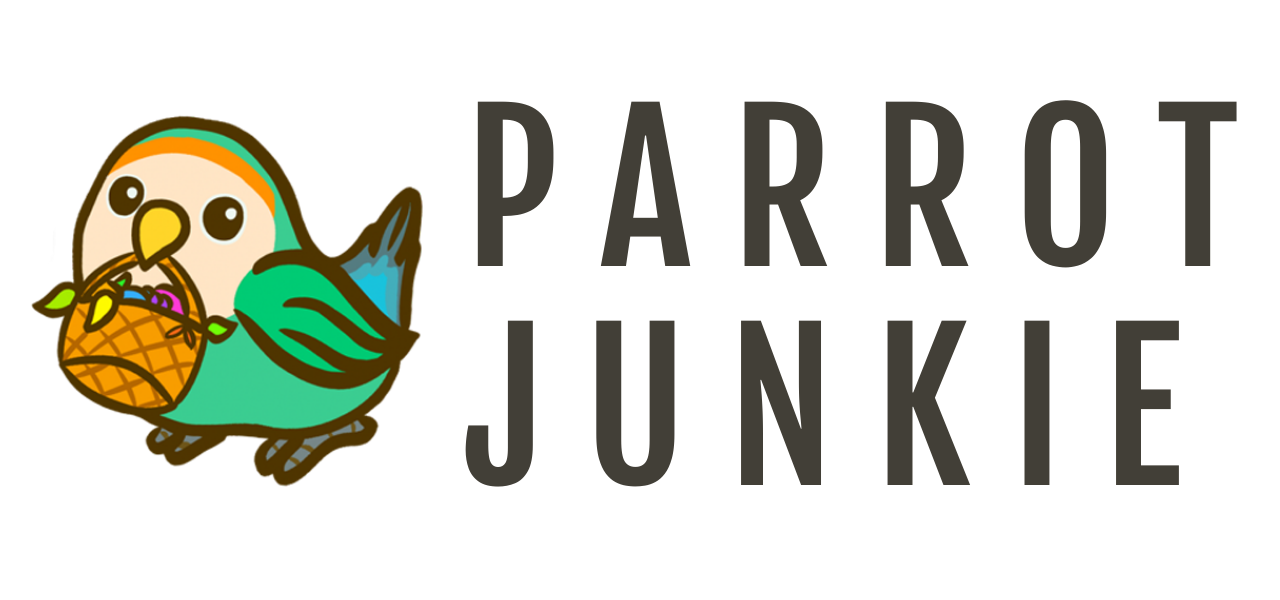

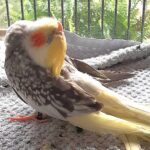
Be the first to leave a comment